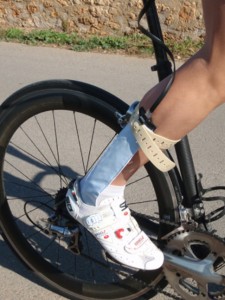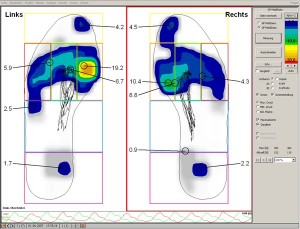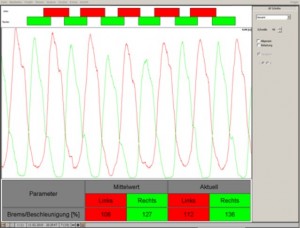Contact point foot-pedal
There are two reasons why the pedals as points of contact are of interest for a biomechanical analysis. First, it is worth knowing how strongly the foot is strained when pedalling in order to prevent eventual pain from occurring. Second, this is the point of contact that is responsible for the crank’s movement and accordingly for the thrust of the whole bike.
Load Analysis
From a biomechanical perspective, the connection of pedals and shoes through the cleats is interesting. In normal walking or running there are different phases of gait: First, the heel touches the ground. Second, the weight is shifted on the midfoot and third, the toes push off the ground. Through this rolling movement the weight has to be carried by different parts of the foot over the course of one single step.
In contrast, when pedalling the force rests on the forefoot solely. As advantage there is a considerable lower shock impact in comparison to running, i.e. ligaments, tendons and joints are less loaded considerably. However, the small supporting area is disadvantageous for the pressure distribution of the foot. According to the basic physical law: pressure = force per area, a smaller supporting area leads to a higher pressure on the foot’s ball and on the toes (especially the big toe).
This causes the well-known problems of prickling and numb toes, burning feet or numbness in the area around the foot’s ball. Due to the higher loading frequency (as compared to running) the individual pressure points in the ball area are loaded repeatedly with shorter phases of unloading.
Dynamic pressure distribution measurements while riding are used to record and analyse the pressure on the feet. In this way typical pressure points can be located.
Based on these pressure distribution measurements some provisions can be taken to reduce the maximum pressure. Amongst other one can (a) choose a fitting shoe, (b) find the optimal position for the cleats, or (c) select appropriate insoles. It has been found that different shoes may well cause different pressure patterns (when holding everything else constant (position, cadence, resistance). Also changing the positioning of the cleats (to the front/back, left/right) can have certain effects.
Just as for running shoes, insoles have probably the largest effect on the pressure distribution. By slightly lifting the area of the foot’s longitudinal arch or by lifting the retro-capital region (the area between the foot’s ball and longitudinal arch) partly pressure values can be reduced, because the load is distributed over a larger area. The better the insole is fitted to the rider’s foot and his needs, the better is the load situation for the foot.
Performance Diagnostics
The second aspect of the pedal as a point of contact is the ‘performance diagnostics’. The leading question in this regard is under which conditions the rider reach the optimal performance, i.e. to achieve the best thrust through the transmission of power onto the pedals. For this purpose three mechanical parameters are of relevance: cadence, pedalling force and power.
Cadence (i.e. the pedalling frequency) is given in the unit [1/min], measuring the number of crank rotations per minute. It accordingly is a measure for the pedalling speed. Due to the fixed interconnection of the pedals the cadence of the left foot is identical to that of the right one.
The force is measured in Newton and gives the strength of pedalling. When considering a longer period, there is a force-time-plot which differs for the two feet generally.
When pedalling there is a pushing phase, lasting from the upper to the lower pedal position – assuming roughly . During this phase the maximal power is transmitted to the pedals. In the subsequent pulling phase, lasting from the lower to the upper crank position – again assuming roughly, the interaction power between foot and pedal is low. In the best-case scenario negative power is possible referring to a real pull on the pedals. However, the measurements conducted so far have revealed that few riders are able to generate such a pull in practice. It is obvious that the phases of pushing and pulling are contrary for the left and the right foot – while the former pushes the latter pulls and vice versa. It is the sum of the forces of the two feet at each moment in time that determines the thrust.
The parameters cadence and force can be used to determine the rider’s power. Over a longer period this determines the average speed achieved over the distance ridden. The performance can be enhanced by increasing the force on the pedals or by increasing the pedalling frequency.
A major shortcoming of the conventional systems employed for performance diagnostics is their inability to break the total power down for the left and right foot respectively. The development of such a measuring system and the corresponding software allowing the left/right differentiation under realistic circumstances is an important task for the near future. This would make left/right comparisons concerning the symmetry of pedalling possible and so it could be used to enhance round pedalling.





